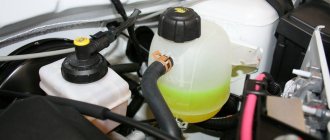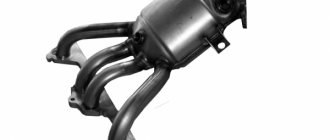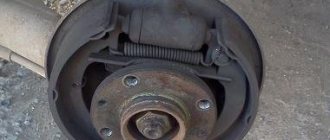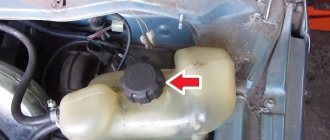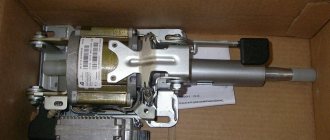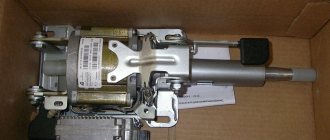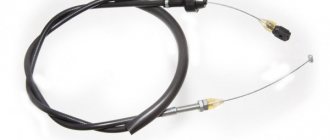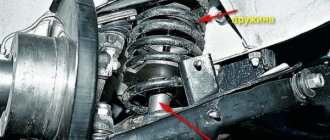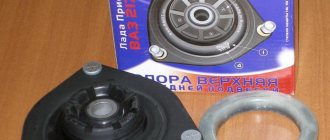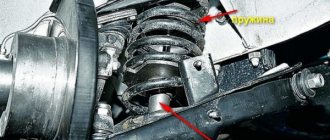Inflates the coolant reservoir of the VAZ 2114
The cooling system reservoir swells and tears along the seams. Replacing the tank cap and the tank itself did not give any results. Could the cause of the tank swelling be due to a leaky cylinder head connection and the cylinder head itself? That is, does the cylinder head gasket itself allow gas pressure to pass into the coolant cavity?
- Strong steam from exhaust 2110 – 5 answers
- The oil sensor came on after replacing the cylinder head in 2110 - 3 answers
- The stove on the VAZ 2110 does not work - 3 answers
- Where can oil leak from above the manifold on a VAZ 2110? – 2 answers
- The cylinder head gasket has smaller coolant holes - 2 answers
Check with a gas analyzer whether there are gases in the expansion tank.
If the engine is not overheated, then the cylinder head gasket lasts until the engine itself is overhauled (that is, it is approximately 150-250 t.km.).
For gases in the cooling system. If the expansion tank plug is working properly, then it should relieve pressure, that's why it has a valve there in the plug. Bloating occurs due to a faulty valve in the tank plug.
... The problem was that the cylinder head gasket had become unusable and began to leak gas pressure from the working chambers of the cylinders into the cooling system of the internal combustion engine. The boost was so powerful that it unraveled the antifreeze tank along the seam - the plug did not have time to bleed it out.
To check, I removed this plug from the expansion tank and tied a balloon to the neck with threads. I started the engine and the balloon began to inflate... May 1 is now far away, opening a company for inflating balloons will not be profitable, so I bought a cylinder head gasket and replaced the old one myself. It was slightly reconstructed, loose...
After replacing the expansion tank (I left the old plug) there are no comments on the operation of these components.
The coolant in the system of a VAZ-2114 car can not only properly perform its tasks, preventing the engine from overheating and heating the interior, but also create numerous problems. This is her nature.
About details
The expansion tank is an important element of the cooling system for any car. When the engine is running, the antifreeze heats up and increases in volume. This increases the pressure and creates the risk of rupture of the radiator honeycombs and pipes. The expansion tank prevents such consequences.
Its main functions are as follows:
- Perception of additional volume of heated antifreeze.
- Relieving excess pressure.
- Release of antifreeze into the system when the engine cools down to prevent air locks.
The part is made of thick-walled plastic. Equipped with a sensor, filler neck and fittings for connection to the cooling system.
What is this?
Or rather, what he looks like. The expansion tank is a container made of plastic. Liquid is poured inside it, which takes part in cooling the motor.
In addition to the hoses that are connected into a circuit, the tank design also includes a float sensor. With its help, information about the temperature of this liquid is transmitted to the car’s instrument panel inside the cabin.
This unit is located under the hood, on the driver's side. You can easily find it right behind the glass counter. Such placement cannot be called practical, since there is metal on all sides of the tank. Therefore, the metal does not allow the plastic to expand properly if the reservoir cap does not work properly.
The result is the same - the container bursts. This problem is especially relevant in the summer, when the car heats up not only from the engine, but also from active sunlight.
Typical problems and their diagnosis
Common faults:
- Violation of the tightness of the tank: the tank begins to leak due to mechanical damage;
- Rupture of the container due to impact or technological defect.
- Problems with the reservoir cap.
Tank cap malfunctions need to be disassembled separately, as this is the most diverse and common group of breakdowns. A clogged cover valve most often causes inconvenience to owners of “fourteeners”. The valve “clogs” due to dirt and stops releasing hot air. This leads to multiple excesses of operating pressure and overheating of the motor.
Also, coolant may leak through the cap, causing the working fluid level to gradually decrease. A leak can be identified by the presence of smudges in the expansion tank.
Common signs of a broken expansion tank:
- traces of leaks on the tank body;
- The engine overheating indicator light is on;
- smoke from under the hood, other signs of significant overheating;
- warm air does not come out of the heating deflectors, despite the fact that there are “symptoms” of a significant increase in the operating temperature of the engine.
Repair or replace the tank?
Some drivers, having noticed that the expansion tank 2114 is leaking, try to repair the crack with glue or epoxy resin.
It should be noted right away that doing this is absolutely not worth it. After all, such repairs, as a rule, are short-lived, and with active use, even the most reliable adhesive seam can leak.
In addition, as already mentioned, the appearance of cracks in the tank is a sign of aging of the plastic caused by depolymerization - the volatilization of a number of fractions from the material that give it plasticity.
Thus, a plastic container that has already cracked can always crack again. That is why replacing the expansion tank of a VAZ 2114 is the most preferable option rather than repairing it.
As for the cover, it is also not repairable, and in case of malfunction it should be replaced with a similar one. At the same time, it is highly advisable to purchase the “native” cover for the 2114, and not its various analogues, the quality (and functionality) of which may be much worse.
If you could not find a cover for the 14th model, then instead you can purchase and install a cover for 2199, since they are completely interchangeable.
Buying Tips
Since the expansion tank for the VAZ 2114 is inexpensive, you should not save on its purchase. It is better to install a new original spare part . If you can’t find it, then you should give preference to parts from well-known manufacturers with a positive reputation. These include Togliatti, Master-M.
to inspect the spare part before purchasing . Even a new part may have defects. The tank must be made of high-strength plastic and have a certificate. It is better to make purchases in specialized stores. There is a higher probability of purchasing high-quality spare parts.
If you still want to save money, then you should consider used options. When choosing such a spare part, special attention must be paid to its condition . It is not recommended to take the tank from a car dismantling point.
To avoid such unpleasant consequences when purchasing online, you should adhere to the following recommendations:
- Choose a proven and reliable organization.
- Do not send money to the seller until you have received and inspected the part.
- Require the provision of a warranty certificate (if we are talking about ordering a new spare part).
- Give preference to those sellers who offer free shipping.
Recommendations for selection
For VAZ 2110-12 models, you can find 2 types of expansion tanks on sale:
- old model with two necks: the coolant level sensor is screwed into the first, and the second is closed with a plug with a release valve;
On old-style products, a second neck was made for installing an antifreeze level sensor
The new sample container does not have a level sensor
If your car has a sensor in an expansion tank, then you need to select an old-style product. Accordingly, versions without a sensor will require a new reservoir design.
For VAZ 2114-15 models, tanks of the same shape are offered with 3 fittings: two of them are located at one end, and the third is located at the opposite end. Products for the VAZ 2110 and 2114 are not interchangeable with each other, although if you really want to, attaching a part from another model is quite possible. Another thing is that there is no need for this - both varieties are available for free sale and practically do not differ in price.
The reservoir for models 2114-15 has a wider shape and a versatile arrangement of fittings
When purchasing an expansion tank for any series of cars of the “tenth” family, pay attention to the following points:
- the plastic of a quality product should be light and half transparent;
- cracks in the corners or near the fittings are unacceptable;
- the plastic should not be “oaky” or have dark impurities visible to the naked eye;
- look on the body for an imprint of the manufacturer's trademark and catalog number (21083–1311014 for VAZ 2114).
For all modifications “ten”, “fourteen” and “fifteen” a small tuning is available - installation of an expansion tank from the cooling system of a Lada Priora car. Why and how this is implemented will be discussed below.
The reservoir of the Priora cooling system has a rectangular shape and 3 fittings on the front wall
Video: how to distinguish an original spare part
Location of expansion tank
A plastic reservoir for excess coolant is installed by the manufacturer in different places depending on the model of the “tenth” family:
- in cars of the VAZ 2110-12 series, the reservoir is located on the left side (in the direction of travel) between the pillar glass and the wall of the interior partition;
The expansion tank on VAZ 2110-12 models is installed in a narrow niche on the driver’s side
- in VAZ 2114-15 cars, the container is also located on the driver’s side, but is placed in front of the pillar glass.
In cars of the 2114-2115 series, the tank is located in front of the pillar
The expansion tank is attached to the body elements with a clamp in the form of a flat rubber belt with a metal hook that hooks onto a protrusion on the side member. There are 3 hoses connected to the tank:
- A large diameter pipe leading from the thermostat is connected to the bottom.
- The upper tube of small diameter goes through the partition to the radiator of the cabin heater.
- The middle small tube connects the tank to the upper fitting of the main cooling radiator.
The reservoir compensates for the expansion of coolant and steam from three elements of the system - the cabin heater, the radiator and the main line near the thermostat
On some modifications there is a reservoir with two fittings and connecting pipes - the large one comes from the thermostat, and the small one from the main radiator; there is no connection to the stove.
Each hose performs a separate function. The thick pipe serves to expand the coolant and fill the system while pouring antifreeze through the neck of the tank. Two thin tubes are designed to drain the steam-water mixture from the stove and the main radiator into the tank when heated to the maximum permissible antifreeze temperature of 95 ° C.
The expansion tank (item 1) is located at the highest point of the cooling system at the same level as the throttle valve
Coolant tank replacement process
General view of the expansion tank
The expansion tank not only serves as an indicator of the amount of coolant in the system, but also when the “coolant” boils, it will come out through it. Usually the latter reason is the reason for depressurization in the system and the appearance of cracks.
In order to make the replacement you will need certain tools. So, what is needed to complete the process:
- Keys for 7 and 10.
- Screwdriver.
- Pliers.
- New tank.
- Sandpaper.
Now that everything you need has been collected, you can proceed directly to the process itself. So, let's consider the sequence of actions aimed at replacing the expansion tank:
- The first step is to remove “casting” defects that will interfere with the normal installation of the pipes. After treatment, the surface should become smooth and the hoses should be easy to put on.
Cleaned cavity of the expansion tank under the pipe
Unscrew the valve and remove it from the tank
Removing the expansion tank
We connect the pipe for exhausting evaporative gases
We check the coolant pipe for leaks and integrity
We connect the pipe and install the expansion tank in place
Choice
21083-1311014 – original catalog number of the expansion tank for the VAZ-2114 family of cars. The part is produced at the factory and has no analogues, but some car enthusiasts come up with modifications to this unit or tuning.
The average cost is 400-500 rubles.
Finalization of the new cover
Unfortunately, the quality of spare parts for domestic cars leaves much to be desired, and it is better to check the new cover on a stand. If the pressure does not hold or excess pressure is not released, you can trim the springs. To do this, the part is disassembled, the sealing rubber is pryed off and removed with a screwdriver. Then use a screwdriver to carefully remove the inner cover and remove the springs.
The large spring is trimmed by one turn, and the small spring by two turns. As a result, the exhaust valve will begin to open at a pressure of 1 atmosphere, and not 1.7 atmospheres. When checking, the inlet valve should bleed freely.
Shortening the plug spring
Purchase of components
There are some helpful tips to follow when purchasing new parts to replace your expansion tank.
- Buy the original. The original tanks are ideal for the “fourteenth” AvtoVAZ model. Therefore, various analogues are inappropriate here. The level of quality and efficiency of the original is much higher.
- If a cover is required, then use the analogue from model 2199. They are fully compatible even with threads. Plus, the practice of VAZ 2114 owners shows that the “nine” cover works better than the original one.
COOLING SYSTEM VAZ 2114
Once upon a time, back in Soviet times, water was poured into a car radiator as coolant. But it was very inconvenient - in cold weather it had to be drained regularly so as not to defrost the system, and in the morning before the trip I had to run around with buckets of hot water. In addition, the cooling jacket in the cylinder block and in the cylinder head suffered from corrosion. Nowadays, water is practically no longer used; antifreeze or antifreeze is poured into the cooling system (CO).
The volume of VAZ 2114 coolant in CO is about 8 liters (7.8 liters according to factory conditions). A car that has rolled off the assembly line can be filled with any coolant; the manufacturer does not adhere to any specific rules in this matter.
But if the fluid runs out or the time has come to replace it, then topping up or replacing is necessary. And here you need to know what is poured into the system, and whether it is possible to mix antifreeze with antifreeze.
ANTIFREEZE
The name "antifreeze" contains Greek and English roots. The Greek “anti” means “against”, the English “freeze” translates to “freeze”. Therefore, the coolant located in the cooling system must not only prevent overheating of the internal combustion engine, but also not freeze in frosty weather. The basis of antifreeze is ethylene glycol, and the freezing point of the coolant depends on how much water is added to the chemical composition. The fluid components do not cause corrosion of engine parts.
The composition can be of almost any color; ethylene glycol itself is colorless. The composition is painted so that it can be seen in case of leakage, and so that it is not drunk by mistake; the antifreeze itself is poisonous. In addition, the old coolant changes color, which means it is time to replace it.
Antifreeze
Antifreeze is a type of antifreeze, only at one time it was specially developed for VAZ cars. It is blue in color and can be concentrated, diluted 60% with water (grade A-40M), diluted 35% (A-65M). The concentrate is not used in its pure form; it is diluted at your discretion, depending on the freezing temperature that is oriented towards in the region where the car is located. Antifreeze has a more aggressive environment, but this does not mean that it is of low quality.
MYTHS ABOUT ANTIFREEZE AND ANTIFREEZE
- Antifreeze is worse than antifreeze. This is not true. Both coolants are made from the same base (ethylene glycol). But their density is different, and different instruments (hydrometers) are used to measure this parameter.
- The color of a liquid is an indicator of quality, and its composition depends on the color. In fact, the composition of the coolant is basically similar for all, and does not depend in any way on the color. Antifreeze is mainly tinted green and red.
